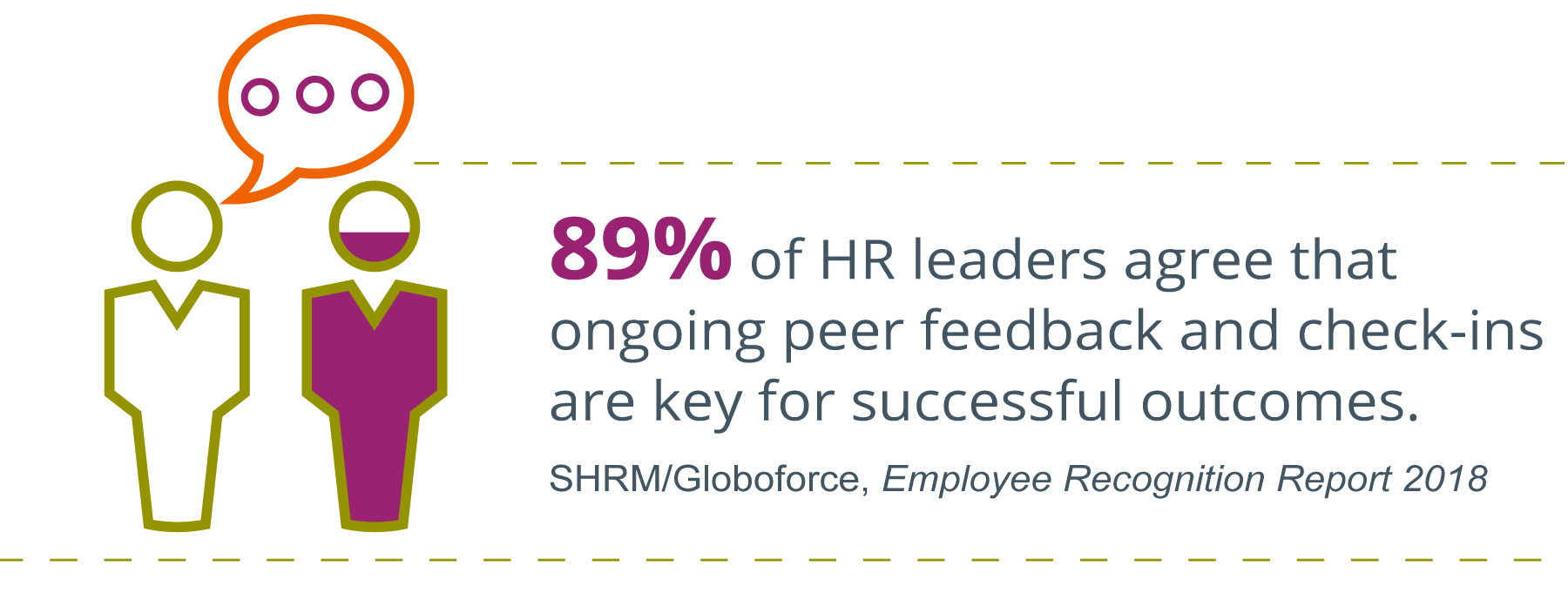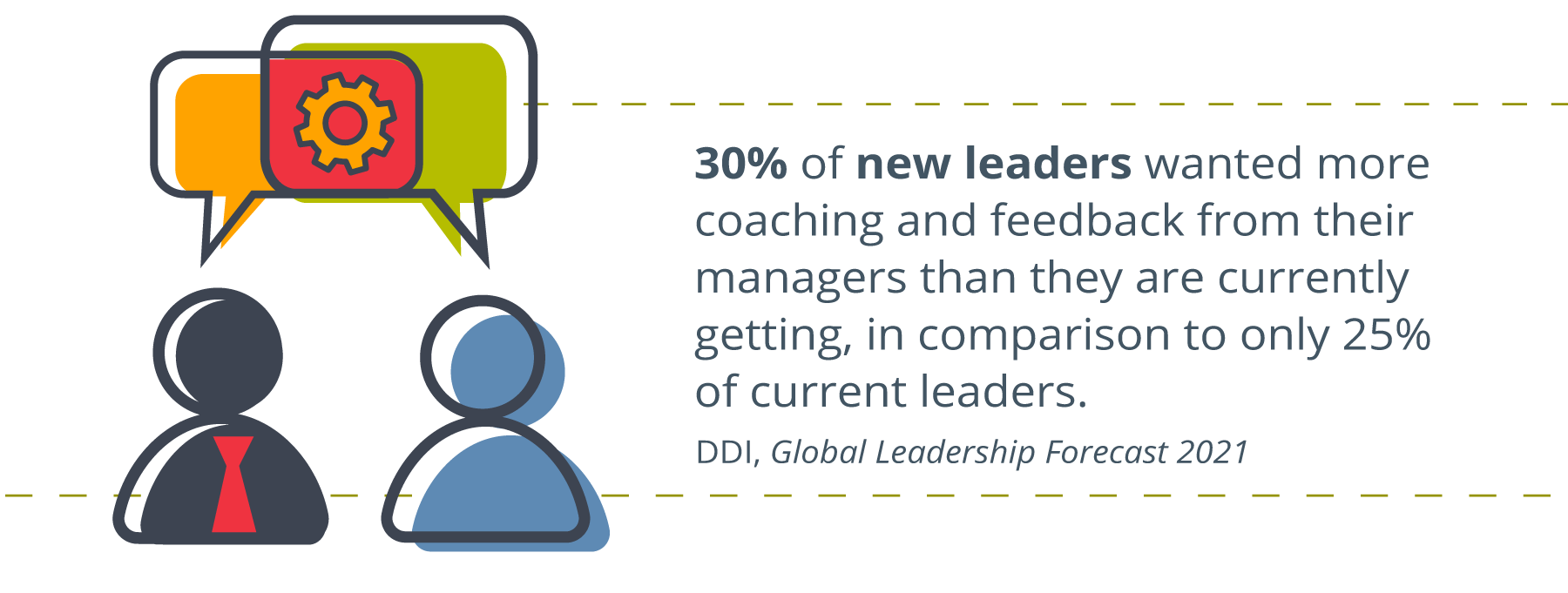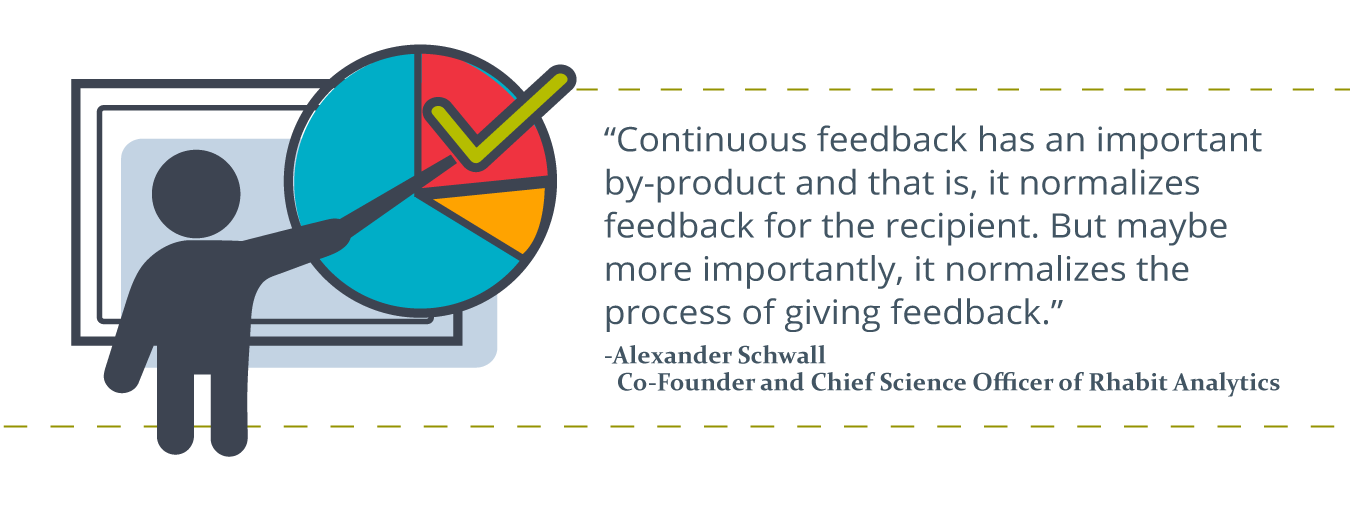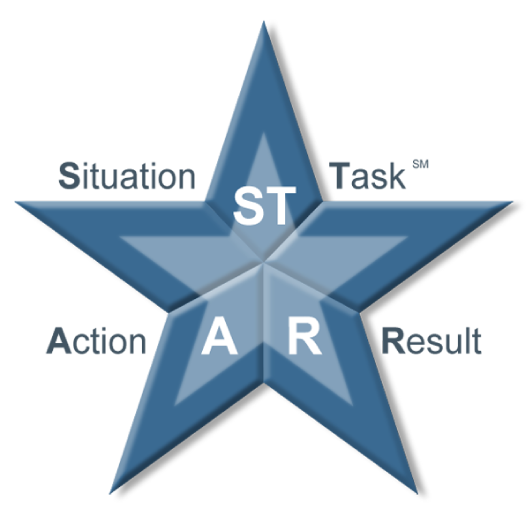Feedback Is Core to Behavior Change
Research shows that receptivity to feedback for personal development is one of the strongest indicators of leadership potential.
If your leaders practice key skills and receive feedback, your organization is 4.6 times more likely to have high leader quality and high bench strength compared to those that don’t.

By being open to feedback, leaders can become more self-aware, which can lead to behavioral change and enhanced emotional intelligence. Surprisingly, most of us are not very aware of our own behavior and even less aware of how other people see us. A study found that about 95% of people think they are self-aware while only 10-15% actually are.
Feedback is key to personal growth and development and it’s also at the heart of deliberate practice. While we may not always like what we hear, we can thrive by being open to feedback. In fact, a deficiency of feedback can lead to anxiety, apprehension, and a decline in productivity. But getting productive, regular feedback can spark exponential growth.
Types of Feedback for Personal Development
It may be tempting to leave the process of giving and receiving feedback open, unstructured, and informal. After all, you want a culture where people organically give and receive feedback without being prompted.
Our research and experience suggest that a formal feedback process not only encourages giving and receiving feedback, but it also helps to reinforce a culture of feedback.
Here are three of the most common types of feedback for personal development:

1. Point-in-time Feedback. The most common type of point-in-time feedback is 360-degree feedback. 360-degree feedback is often used at the start of a leadership development journey or at regular (1-2 year) intervals to obtain feedback on a broad range of competencies and behaviors. It is a good method for identifying broad strengths and areas for improvement as well as insights into a leader’s overall brand and reputation.

2. Pulse Feedback. Pulse feedback is often used as a follow-up to a more comprehensive assessment or feedback process, such as a 360. It is also used to get feedback on personal development priorities during and after leadership training and employee development. Pulse feedback allows leaders to assess progress, typically in a subset of behaviors over a period of time.

3. Continuous Feedback. Continuous feedback allows leaders to obtain feedback on an ongoing basis. It can be used to check on key behaviors across a range of critical leadership moments. The ongoing and repetitive nature of continuous feedback is also very effective when leaders are trying to change old habits or reinforce new habits. In contrast, 360-degree and pulse feedback tend to be driven by an event that occurs at a moment in time based on a specific need. As such, 360s and pulse feedback tend to support development across macro moments.
The Emergence of Continuous Feedback
While point-in-time and pulse feedback methods remain relevant and important uses of feedback for personal development, new approaches based on continuous feedback are gaining significant momentum. Josh Bersin, a well-known analyst and commentator in the leadership and talent industry, describes continuous employee feedback as the next killer app.
It makes sense: The needs of leaders and organizations are not episodic. Leaders and organizations need ongoing feedback and support during daily critical leadership moments such as project meetings and one-on-one discussions.
Gauging progress and performance at work without feedback systems can be hard to achieve. With the rise of remote and hybrid work, we’re also seeing a significant shift in how leaders and employees engage with each other and obtain feedback. That’s why it’s more important than ever to offer leaders continuous feedback mechanisms that are simple to use, engaging, and insightful.

Continuous feedback systems do not function the same as traditional, survey-based platforms. They have unique characteristics that make the process of giving and receiving feedback far more dynamic. Common characteristics include:
- The process of giving feedback is quick and easy. It is focused on a small set of relevant and specific behaviors.
- Technology, including mobile compatibility, is key. Technology drives the process for giving, receiving, and reviewing feedback. Platforms leverage a mix of push and pull feedback options.
- It is engaging. For example, some platforms use swiping and gaming features to gather feedback.
- The process of gathering feedback is anonymous.
- Data and insights are readily available through personal dashboards.
- Individual data is combined to deliver group trends and insights.
5 Best Practices for Giving and Receiving Feedback

In addition to making feedback tools more readily available, companies also need to reframe workplace perceptions of feedback. Too often feedback has negative connotations and is considered by many a vehicle for sharing what is wrong. Feedback must be seen as constructive and positive, a vehicle for driving change, new habits, and innovation—even when feedback is for improvement. This shift applies to those giving and receiving feedback.
Continuous feedback systems can help reinforce a culture of feedback and psychological safety in which freedom to try new behaviors and experimentation with new ways of working are encouraged. But no matter how feedback is given, the core principles remain the same and should be promoted and reinforced as part of any leadership development initiative.
Here are five important principles to keep in mind. Feedback should be:
- Relevant and Specific: Whether giving or receiving feedback, focus on specific behaviors and actions, not broad generalizations. When discussing feedback for improvement, consider sharing and exploring alternative actions. Link feedback to goals and context.
- Timely: Deliver or request feedback as close as possible to the moment a behavior or outcome occurs.
- Delivered with Empathy: Deliver and receive feedback with sensitivity and empathy. Why? Giving and receiving feedback represents a moment of vulnerability.
- Sincere: While it is tempting to surround feedback for improvement with lots of positives, don’t drown out key messages with white noise.
- Treated as a Gift: If you’re not ready to ask for feedback, you may not be ready to credibly deliver it.

DDI designed the STAR method for giving feedback and communicating in a behavioral interview. It’s based on three simple components (ST: Situation/Task, A: Action, and R: Result). You can read more about it here.
Don’t Forget About Feedback for Personal Development
Feedback is crucial for leaders’ growth and personal development. But it’s also a driver of self-awareness, which is key to behavior change.
By making feedback for personal development an important element in your leadership programs, you’re on your way to building a culture that values feedback. When more team members are comfortable regularly giving and receiving both positive and developmental feedback, they’re likely to be growing. Feedback is a gift indeed!
